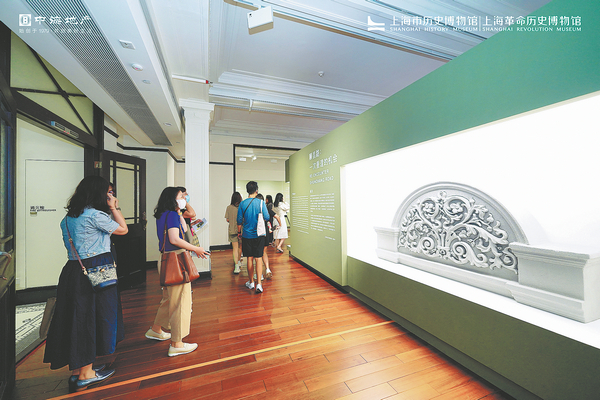

The road, which was renamed Shunchang Road following the war, is still home to some of the old buildings from the past, though all of them are in bad condition due to overuse for decades. As such, China Overseas Property is currently working on the restoration and commercial development of Shunchang Road and the historical buildings.
According to Jin Tian, the general manager, the company has been comparing the century-old blueprints of the buildings with a new survey and mapping of the area, so it can restore and renew Shunchang Road.
The second part of the exhibition features the historical architecture of the area, especially the shikumen houses. Along the road are many of these two-story buildings dating back to the early 1900s. The ground level of these buildings was often used as shop space while the second story was used as the household's residence.
Shikumen houses are named after their stone-framed gates, and a typical unit consists of a small patio, a living room, bedrooms, a kitchen, the dormer window on the roof, as well as a small garret above the kitchen called tingzijian.
A typical shikumen gate usually had Western-styled columns and granitic plaster was often used instead of marbles and other types of stones due to economic reasons. The wooden gate, however, was often decorated with Chinese-style tablets surrounded by auspicious Chinese patterns or Western geometric shapes.
The decoration of shikumen houses reflects how traditional Chinese culture was integrated with different schools and styles of Western architecture, and has great cultural and historical significance, says Zhou.
Aside from presenting original components disassembled from the shikumen buildings, such as capstones and wooden stair railings, the exhibition also has a detailed presentation of the materials, tools, methods and techniques used in the construction of these houses, thus providing visitors with a glimpse into China's industrial development.
The exhibition also highlights how different houses are being protected and restored today. A mechanical model displays how an entire building can be moved literally without damaging its structure and stability.
The third part of the exhibition presents the different looks of Shunchang Road through the past century, and the fourth features a projection of the renovated area, which will host new commercial and lifestyle centers that will be joined with the established commercial area of Huaihai Road.
With many museums, historical sites and other landmark buildings located nearby, authorities are hoping that similar crowds to those of yesteryear will once again throng Shunchang Road.
If you go
Re-encounter Shunchang Road
June 16-July 25, 9 am-5 pm (last entry at 4 pm), Tuesday-Sunday
3F, West Wing, Shanghai History Museum, 325 Nanjing Road West, Huangpu district, Shanghai
021-2329-9999